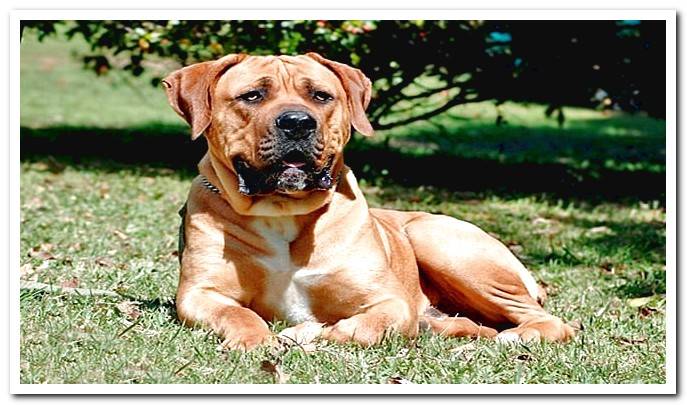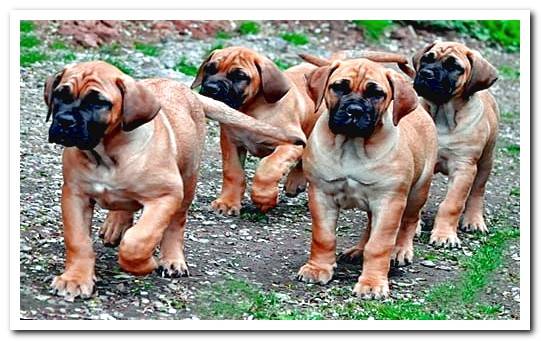
At first glance, you might think that the large and intimidating African Boerboel, also called the South African Mastiff, is an excellent guard dog, fierce and fearsome. But while that is true, this dog is also very family-oriented, calm and loving, especially with children.
It is a docile and sometimes somewhat stubborn dog, although it is territorial with a good education and care, we can diminish that behavior so common in dogs.
From Dogsis we will show you all the information about this breed, what precise feeding, necessary care and behavior. So you can enjoy it, as much as yours.
Index of contents
- 1 Character and behavior of the African Boerboel breed
- 2 Boerboel physical characteristics
- 3 Boerboel Dog Education and Training
- 4 Recommended care
- 5 Breed history
Character and behavior of the African Boerboel breed
The Boerboel is naturally playful, intelligent, and always eager to please. As is often the case with field dogs, he is happiest when he has a job to do and has a place to run.
He adapts perfectly to family life, especially with children, with whom he is especially protective, sometimes even excessively. His affectionate, playful and even somewhat clown character sometimes make him unique and very funny.
The same instincts that make the Boerbel an excellent watchdog can also make it aggressive if we don’t educate and socialize it properly. So investing time in your education is essential.

Boerboel physical characteristics
Both its physical complexion and its size make the Boerboel an imposing dog. Its height at the withers is between 65 and 75 cm in males and between 60 and 65 cm in females. The weight that adults reach can reach 90 kg and even more. It is, in short, a very large and powerful dog, but incredibly agile.
His body is muscular and well proportioned. Its head is also large and wide, with a black snout and large nostrils in the nose. It has “V” shaped ears and the color of its eyes varies between different shades of brown and yellow (some specimens may have blue eyes).
The Boerbel’s hair is very short and soft to the touch. The most common coat colors are yellow, dark red, brown and brindle. He often has a black mask, that is, black hair around his eyes and mouth.
Boerboel Dog Education and Training
When it comes to training, the Boerboel tends to be dominant, so it will be up to us to be confident and to be very strict. In short, establish limits and set the guidelines, although always using the effective resource of positive reinforcement and not being excessively severe.
A progressive training technique Patient and constant will be easier if it is accompanied by an early socialization process, essential to prevent the aggressive impulses of the Boerboel.
This dog requires a lot of mental and physical stimulation, otherwise it can fall into boredom or anxiety, which is the prelude to destructive behaviors. Long walks, vigorous play sessions and the occasional intellectual challenge will help us provide you with the activity you need.
Also, being a high-volume dog with moderate exercise demands, the Boerboel needs plenty of room at home, so not the ideal dog to have in a flat or apartment. It is best to have a patio or garden where you can run safely.

Recommended care
The Boerboel is considered a very healthy breed of dog that does not require too much care. However, he is predisposed to suffer certain ailments and physical problems, especially in his last years of life, such as hip or elbow dysplasia, some heart conditions and disorders that affect the eyelids, to name the most common.
Beyond that, regular care of the Boerbel is fairly simple. You have to cut your nails every two weeks and you should brush your teeth regularly, although always following the instructions of our vet. A brushing a week and a bath once a month will be enough to keep your coat healthy.
Breed history
This breed was bred and trained to help South African farmers defend their homes from attack by hyenas, lions, and other wild animals. In fact, its name comes from Afrikaans, the dialect of Dutch spoken by South African boers, and its translation is something like “the farmer’s dog”.
The Dutch colonists brought many dogs of different breeds to the south of the African continent, mainly bulldogs and mastiffs, which they bred and bred until they found the type of dog they needed to work on their farms and keep their land: the Boerboel.
In the 20th century, with a less rural and more urbanized country, this dog was losing its place in South African society and was on the verge of extinction. Luckily, a group of Boerboel enthusiasts launched in the 1980s to recover the breed and start exporting it to the rest of the world. Still, today the Boerboel is still quite difficult to find outside of South Africa.
